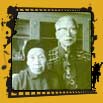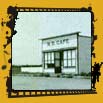 Heritage Community Foundation Presents
Heritage Community Foundation PresentsAlberta Online Encyclopedia
 |
 |
 |
|||
     |
Legacy Article "Photographer George Webber" Photographer George Webber captures "the heroic quality of simply lives." It was summer in New Dayton, a hamlet south of Vulcan. Heat swept across the vast, empty. Alberta prairie and clung to the line where land met sky. "Just wait for a minute," New Dayton storekeeper Charlie Chew Leong told the man with the camera. "Just wait." Chew shuffled to the back of the store, ragged, round-toed sneakers carrying his 93-year-old frame past glass cases of Drum tobacco, Wrigley's gum, and Colgate toothpaste—country store confectionery. Moments later he returned wearing a tie. With him was his wife. Lee Chun, a small Chinese woman who spoke no English. "Okay," Chew told the man with the camera who had wandered into his little country store and requested a photograph. Now could he take another picture? The photographer would not realize until years later that this picture documented an extraordinary story. That summer day in 1988, he had captured on film the culmination of 55 years of patience. Chew's story is that of a Chinese immigrant who came to Canada to start a better life for his wife and children. Because of circumstance and immigration laws, he never saw his children again. But in 1986, after being apart for over half a century, Chew and his wife were reunited when she came to live with him in the back of his small store in the heart of the Alberta prairie. That this story was documented by accident is extraordinary. But George Webber, the man behind the camera that day, is no stranger to the extraordinary. As a photographer devoting much of his work to the vast prairie landscape and the lives of its inhabitants, Webber has borne witness to many remarkable stories. For Webber, it all begins with the land. His work, his experiences, and his temperament are rooted in the prairie landscape where he spent his childhood. Those prairie roots are evident in Webber's collection, Requiem: The Vanishing Face of the Prairies. The photographs tell the stories of people and places of the prairie, emphasizing the contrast between the rugged landscape and its vulnerable inhabitants. "There's something very dramatic about the contrast," Webber says. "You're looking at really big space and very small people or flat prairie contrasted with vertical structures." Webber's interest in this contrast and his affection for the land began when, as a young boy in Drumheller, he was given free rein to explore the badlands behind his grandfather's rural home. "I felt euphoric to be able to explore and enter into that magic place on my own." The euphoria, he explains, came from the sense of " the world being a safe place" that this freedom to explore afforded him.
"There was a sense of knowing your place, and it was a good place," he says. Although his family moved to Calgary when he was seven, Webber never forgot the magic of the badlands. Years later, when he was in his 20s and first discovering photography, he returned to Drumheller to capture the prairie's allure through a camera's lens. Webber soon discovered this magic throughout the prairies. Small towns, Hutterite colonies, and the Blood reserve, he learned, were particularly fertile territory. And it has been in this territory that Webber focused his work, documenting the day-to-day lives of communities that are traditionally closed to outsiders. "Photographing the Hutterites and people on the Blood reserve is like a courtship," he says. "You meet someone, you talk to them, and you show them your work." Even in small towns, he explains, people have to "take your measure" before they will let you photograph them. This courtship has paid off for Webber, who has earned impressive accolades for his work, including a 1999 induction into the Royal Canadian Academy of the Arts. However, for Webber, the real pay-off comes in less measurable terms. "There's something really extraordinary about being invited into the lives of others and for those people to simply, transparently, tell you their story." Webber believes these normally reclusive communities have welcomed him because he is sincerely interested in their lives. He says people can intuit "gentle impulses" and his desire to honour their stories. It is these stories, after all, that Webber treasures most. He believes that each photograph is a kind of blessing and says he's often amazed by the strength and the noble character of his subjects. "There is something about a life lived with some measure of courage or tenacity. It's inspiring...I am deeply drawn to the heroic quality of simple lives." It was this fascination that drew Webber back to Charlie Chew Leong's store in New Dayton, years later. He arrived to find the Chews' store boarded up—closed, according to the owner of a new confectionery, because both Chew and his wife had passed away four years before. The storekeeper gave Webber the name of Chew's grandson in Red Deer, who later revealed the story of the couple's 55-year separation and helped him understand what the photograph had actually documented.
Wandering through the empty store, behind the dusty counters, Webber found a box of pictures that the town's children had given Chew over the years: poignant testimony to the loneliness Chew must have felt, separated from his family for most of his life. Then Webber stepped in front of the counter and stood in the place where the couple had posed for their portrait. Across from this spot was a small window looking out to empty prairie divided by the railway line. "I had a profound sense of her [Mrs. Chew] looking out the window at that long line," Webber recalls. There she was, a woman from a large city in China, who suddenly found her tiny frame contrasted with Alberta prairie, living with a husband she had not known for over 50 years. "The prairie can be quite a terrifying and lonely place if you aren't intimate with the landscape," says Webber. Documenting people's courage in defiance of this sometimes terrifying landscape brings Webber a sense of utility in his work and allows him to revisit the sweeping panorama he feels is very much a part of who he is. "There's something about the slowness and the space of the prairie that's integrated into my whole being. The flatness is very soothing to me," explains Webber. Carolynn Van de Vyvere is a freelance writer in Calgary. |
|
|||
|
|
|||||
|
Copyright © 2003 Heritage Community Foundation All Rights Reserved |
|||||
 |
 |
 |
For more on Alberta's Arts Heritage, visit Peel’s Prairie Provinces.





